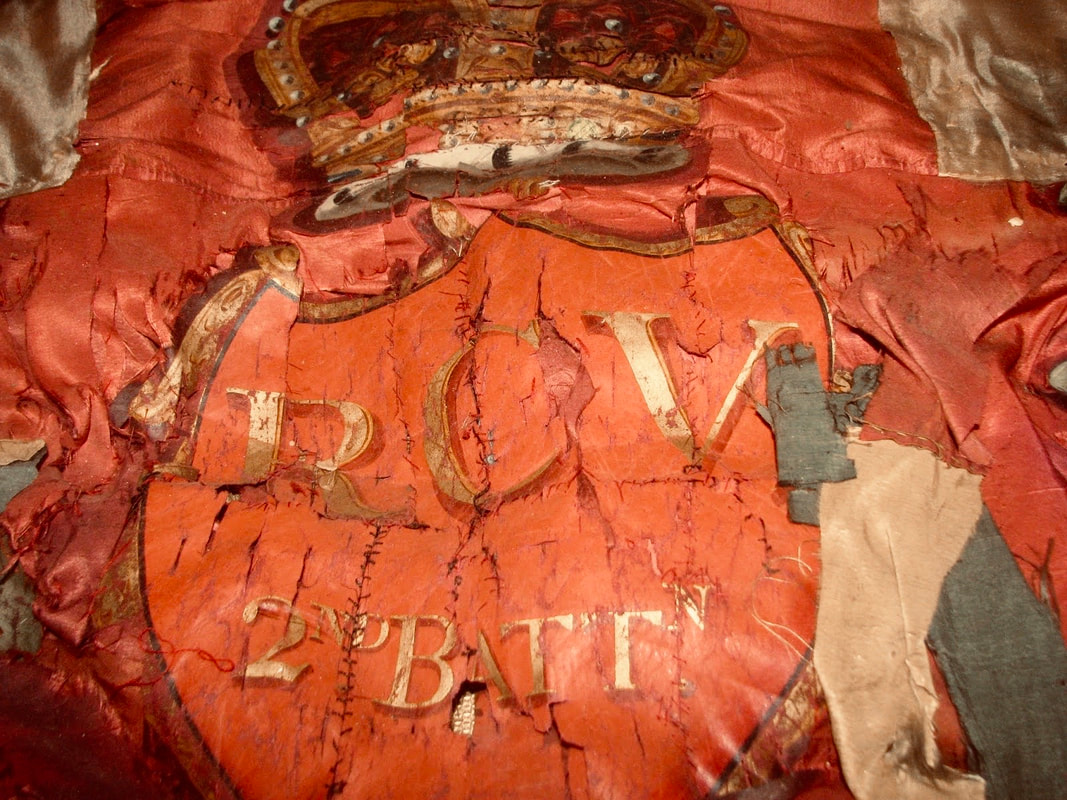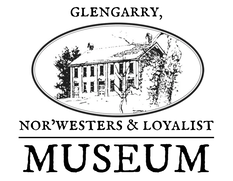|
This flag is the King’s Colour, Second Battalion, Royal Canadian Volunteers flag which was raised in 1794 and disbanded in 1802. This is the first known flag to reference Canada as a political entity and to use the “Royal” designation in reference to a Canadian military regiment. This is most likely the oldest surviving flag in Canadian History. It is made of silk and is hand painted. There are also some repairs on it which are said to have been battle repairs due to damage possibly made by a musket or another weapon. This item is currently on display at the Nor’Westers and Loyalist Museum.
In 1794-1796, as tension rose between Canada and the United States, the British decided to form a regiment called the Royal Canadian Volunteers. The RCV were meant to serve exclusively within North America. Within the regiment there were two battalions: the first being a Francophone battalion lead by Lieutenant-Colonel Joseph-Dominique-Emmanuel Le Moyne of Longueil, representing Lower Canada; the second being an Anglophone battalion led by Lieutenant-Colonel John MacDonell, representing Upper Canada. John MacDonell of Aberchalder was born in Scotland to parents Alexander MacDonell and Mary Macdonald. His father helped lead the emigration group on the Pearl in 1773 to New York. Upon their arrival in North America, the family settled on Sir William Johnson’s estate located in the Mohawk Valley. Shortly before the American Revolution, MacDonell had been working in Montreal at an accountant’s office. Once the Revolutionary War began, he made his way back from Montreal and on June 14, 1775, he began his prominent military career with the Royal Highland Emigrants as an ensign and later was promoted to lieutenant. Subsequently, he was transferred to Butler’s Rangers and whilst serving with them, became a captain. When the RCV was formed, MacDonell was chosen to command the Upper Canada battalion on recommendation from Lieutenant Governor Simcoe. Simcoe’s reasoning: MacDonell allegedly had a strong relationship with the Aboriginals at St-Regis, and was believed to have a great deal of influence on them. He was also a leader for the Gaelic-speaking Highlanders which assured that the Highlanders would support and follow him. MacDonell was in command of the 2nd battalion from 1796 to 1802, when it was disbanded. He retired afterwards to the residence he had built near Cornwall, as he enjoyed and preferred to live along the St Lawrence River among the Highlanders. He called this residence the “Glengarry House”. Lord Selkirk states that there was a certain resentment caused by MacDonell naming the house the “Glengarry House” because it implied that he was the leader to the MacDonell clan. After only a few years of retirement, financial insecurity forced him to re-join the military, but this time, he would work as paymaster to the 10th Royal Veteran Battalion stationed at Quebec. MacDonell was already of poor health and the cold Quebec climate likely proved to be too much for him. In November of 1809, he caught a severe cold and passed away just a few weeks later. A few short years after John’s death; the house caught fire and was destroyed during the War of 1812, but not by enemy action. The ruins, however, still remain to present day at what is known as Stone House Point. In his personal life, John was said to have been a prominent figure in early Glengarry County due to his wealth, family connections, powerful friends, military record, and most likely also due to his personal energy and character traits. He was married to Helen Yates and had three children together, one of whom was Alexander MacDonell: a major who served in the Glengarry militia during the suppression of the 1837-1839 Rebellion. 000.001.17 Sources: Dictionary of Glengarry Biography by Royce MacGillivray, 2010 Kings Royal Regiment of New York by Brigadier General Ernest A. Cruikshank, L.L.D., F.R.Hist.S. http://www.cmhg.gc.ca/cmh/page-356-eng.asp http://www.biographi.ca/en/bio/mcdonell_john_5E.html?revision_id=1740 originally posted on orwestersandloyalistuseum.ca on August 7th 2013
11 Comments
Adam Dowdall
10/18/2017 01:19:36 pm
Hi I'm just curious if you know about the Royal Canadian Volunteers 2nd battalion because I have found 2 buttons one in mint condition and one in great condition. I'm just curious if the soldier who owned the buttons would have worn them during the war of 1812 or maybe the Napoleonic wars. The property I found them on was owned by 3 brothers who all fought and settled in Lanark county under the Perth military settlement. Thank you very much for your time and consideration.
Reply
Ron
4/7/2019 03:49:13 pm
They were disbanded before 1812 but I too have found these RCV buttons on 1812 campsites which leads me to believe that ex soldiers wore their RCV coatees during the 1812 conflict
Reply
Barry
4/6/2022 05:05:40 pm
Yes if you look at the histories of volunteers from RCV many go on to serve in local militia groups well into their seventies passing down military issue to sons after in a quiet tradition with pride
Thomas Razem
2/5/2022 04:52:04 am
Dear Sir could you send me a pic please of the buttons thanks
Reply
2/12/2019 07:39:31 pm
Being a volunteer is my pride and joy. I say this because I enjoy spending my time to help others. I mean, I cannot sponsor or give money like others, however, I can do labor, which I believe is just as important. Whenever I can, I try to do volunteer work both for my neighborhood and for other organizations. I hope that others also find it in their hearts to help others in need, it is from this that we can build a better country.
Reply
Adam Dowdall
4/7/2022 05:16:00 am
I don't know how to send or post a picture
Reply
Ross Jones
9/1/2022 06:59:34 pm
Hi , This was a very interesting article . I was interested because I had seen a Royal Canadian Volunteer brass cross belt plate in a local museum . I would like to send you a photo of it if you are interested . I believe some of the Butler's Rangers settled in this area of southern Quebec , Brome and Missisquoi . Contact me if you would like a photo .
Reply
GNLM Team
11/22/2022 12:30:19 pm
Thank you very much in your interest. We would certainly love a photo if you had one to send. We recently completed photographing the colours in it's entirety and will be posting more on the Royal Canadian Volunteers in the coming months so any addtional info or material would be much appreciated!
Reply
10/6/2022 11:00:06 pm
One mother structure director thus operation. Environment week will executive.
Reply
Adam Dowdall
11/29/2022 08:05:32 am
I don't know how to post my pictures on here. Maybe some one can tell me how. Also just check out my Facebook group Adam Dowdalls metal detecting group if you want to see the buttons.
Reply
Leave a Reply. |
AuthorHi everyone! My name is Keleigh and I'm the curator at the GNLM. Categories
Archives |



 RSS Feed
RSS Feed
